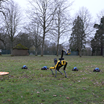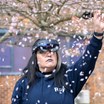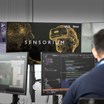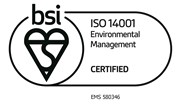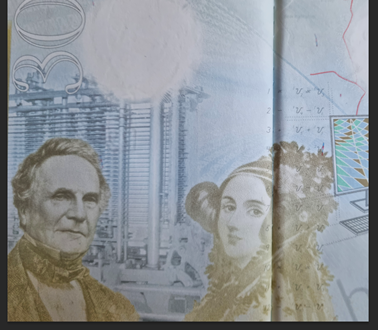
What do a NVIDIA GPU, a character in Doctor Who, a cryptocurrency and the second Tuesday in October all have in common? Answer: They are all named after and dedicated to Ada Lovelace.
Never knowing her estranged father, Ada was inspired by her mother to focus her academic efforts on science and maths. At a time where there were no places for women in UK universities, girls from wealthy aristocratic families were afforded the privilege to an education through private tutoring. Their societal connections gave Ada access to mentors like Mary Somerville - the first person to be described in print as a 'scientist' in 1834 and now features on Scottish £10 notes – through whom her academic network grew.
A passion for innovation
Approaching adulthood, her focus on mathematics grew and she was introduced to Charles Babbage through their mutual friend Mary Somerville. Ada would visit Babbage regularly and became fascinated with his work on the ‘difference engine’, impressing him with her intellect and analytical skills in their subsequent regular correspondence.
Early computing attempts
In 1832, Babbage had a working one-seventh scale model of the ‘difference engine’ produced - a mechanical computing device designed to tabulate polynomial functions. Subsequently, however, government funding ran out before achieving a full-size working machine of his design (this was later commissioned by the London Science Museum, completed and fully operational in 2002).
By this time, Babbage had already begun work on the Analytical Engine, a proposed Turing-complete mechanical general-purpose computer to be program controlled by punch cards. The machine was designed to have four components, the mill, the store, the reader and the printer, similar in concept to our modern day CPU, memory, input and output devices of computers.
During a promotional trip to Turin, Babbage met mathematician Luigi Menabrea, who began writing about the machine. His work was published in Switzerland in 1842.
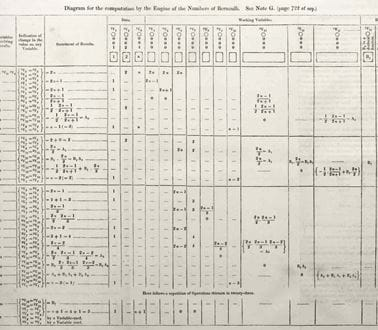
Imagining the first algorithm
Lovelace, who had followed closely the developments of his invention, was commissioned to translate Menabrea’s work from French, and to add her own notes. This translation, published in 1843 under the initialis AAL, represent her greatest contribution to computer science, distinguishing it from the science of mathematics. Babbage later wrote that the “author has entered fully into almost all the very difficult and abstract questions connected with the subject”, describing with clarity the inner workings of the machine. She writes in the adjacent image, a method for calculating a sequence of Bernoulli numbers, which is considered the first published algorithm specifically tailored for implementation on a computer.
Was Ada the first computer programmer?
“The science of operations, as derived from mathematics more especially, is a science of itself, and has its own abstract truth and value,” – Ada Lovelace
In a biography written by James Essinger, this line was interpreted, writing “Ada is here seeking to do nothing less than invent the science of computing, and separate it from the science of mathematics. What she calls ‘the science of operations’ is indeed in effect computing.”
Her work went further than documenting the workings of the analytical engine. She articulates the poetic significance of his invention, imagining its future power and significance. Her statements were more visionary and conceptual than Babbage’s, and were well respected at the time by fellow academics, such as Michael Faraday, the English scientist who discovered electromagnetic induction.
The science of computing is something we know a lot about at Roke, and programming is involved in almost everything we do.
Ada’s legacy
- Around 1980, a new programming language, named Ada, was commissioned in part by the US Department of Defense and UK Ministry of Defence (MoD), to support safe modular programming and reduce the number of different programming languages used on embedded computer system projects
- NVIDIA has recently launched the Ada Lovelace GPU, claiming to provide efficient revolutionary performance for ray tracing and AI-based neural graphics
- An Ada Lovelace character featured in BBC’s Doctor Who on the 5th January 2020, meeting the Doctor and travelling through time
- Ada is also a cryptocurrency, and as of November 2015, all new British passports have included an illustration of her and Charles Babbage
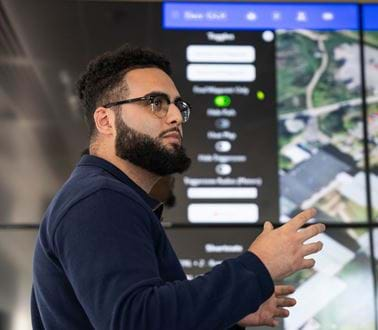
Creating our own pioneers at Roke
In recent years, celebrations of Ada’s achievements are found all around us. Ada Lovelace Day, founded in 2009 to be held on the second Tuesday of October, is an annual international celebration of the achievements of women in STEM.
Undoubtedly, Ada’s success can in part be attributed to the support and connections she gained through her mentors. Here at Roke, we appreciate the value these relationships bring and run a formal Mentoring Program throughout the year, which we know our colleagues benefit hugely from. We acknowledge that women are underrepresented in STEM industries and run outreach activities such as our Girls in Engineering Day that are curated especially to inspire young women to consider a career in STEM.
Could you be the next Ada Lovelace? Join us now to develop your skills in computing, AI and more.
Related news, insights and innovations
Find out more about our cutting-edge expertise.




